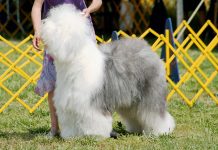History and Origins of the English Setter Breed

The English Setter is a distinguished and elegant breed with a rich history dating back to the 14th century in England. The breed was developed primarily for bird hunting, specifically for locating and pointing gamebirds like quail and grouse. English Setters are believed to have descended from a combination of Spanish pointers, large water spaniels, and other land spaniels.
The modern English Setter’s lineage can be traced to the kennels of Edward Laverack and R. Purcell Llewellin in the mid-19th century. These breeders refined the English Setter’s hunting abilities and appearance, establishing distinct lines known as the Laverack type (show lines) and the Llewellin type (field lines). The English Setter was recognized as a distinct breed by the Kennel Club in England in 1873 and by the American Kennel Club (AKC) in 1884.
English Setters quickly gained popularity as versatile hunting companions and beloved family pets. They are known for their excellent scenting ability, stamina, and graceful hunting style. Today, English Setters are still valued for their hunting prowess and make wonderful companions for active families due to their friendly temperament and affectionate nature.
Physical Characteristics and Appearance of English Setters
The English Setter is a medium to large-sized dog with a graceful and athletic build. They are known for their distinctive feathered coat and noble expression. Here are the key physical characteristics and appearance traits of the English Setter:
- Size: English Setters are medium to large-sized dogs. Adult males typically stand between 25 to 27 inches (63 to 69 cm) at the shoulder, while females are slightly smaller, ranging from 23 to 25 inches (58 to 63 cm). They usually weigh between 55 to 80 pounds (25 to 36 kg).
- Coat: The English Setter’s most notable feature is its beautiful coat, which is flat, silky, and feathered. The coat comes in various color combinations, including blue belton (blue and white), orange belton (orange and white), tricolor (black, white, and tan), and lemon belton (lemon and white). Regular grooming is necessary to prevent matting and keep the coat looking its best.
- Head: The breed’s head is refined and balanced, with a slightly rounded skull and well-defined stop. English Setters have expressive dark brown or hazel eyes that convey intelligence and gentleness. The ears are long, hanging close to the head, and covered with silky feathering.
- Body: English Setters have a muscular yet elegant body with a deep chest, strong back, and well-sprung ribs. The hindquarters are well-developed, providing power and agility for efficient movement in the field.
- Tail: The tail is moderately long and carried in a horizontal or slightly upward curve. It is adorned with feathering that complements the coat.
- Gait: English Setters move with a graceful and flowing gait, covering ground effortlessly. Their movement is smooth, purposeful, and efficient.
- Expression: English Setters have a kind and intelligent expression. They should exude confidence, attentiveness, and a gentle demeanor.
English Setters are overall well-proportioned dogs with a balanced and harmonious appearance. Their combination of athleticism, grace, and beauty makes them highly recognizable and admired among dog enthusiasts. Proper care, regular exercise, and attention to grooming are essential for maintaining the English Setter’s health and appearance.
English Setter Temperament and Personality Traits
The English Setter is known for its friendly, gentle, and outgoing temperament. This breed is prized for its versatility as both a hunting companion and a loving family pet. Here are the key temperament and personality traits of the English Setter:
- Friendly: English Setters are affectionate and sociable dogs that enjoy being around people and other pets. They are known for their friendly demeanor and gentle nature, making them excellent companions for families.
- Gentle: English Setters have a naturally gentle disposition and are typically good with children. They are patient and tolerant, making them suitable pets for households with kids.
- Intelligent: English Setters are intelligent dogs that respond well to training. They are quick learners and enjoy mental stimulation. However, they can also have an independent streak, so consistent training and positive reinforcement are important.
- Energetic: English Setters have moderate to high energy levels and require regular exercise to keep them happy and healthy. They excel in activities like hunting, agility, obedience, and flyball.
- Playful: This breed retains its playful and puppy-like behavior well into adulthood. English Setters enjoy interactive games and activities with their owners and thrive on companionship.
- Alert: English Setters are alert and make good watchdogs. They will bark to alert their owners of approaching strangers or unusual sounds, although they are not typically aggressive.
- Affectionate: English Setters form strong bonds with their families and enjoy spending time with them. They are known for their loving and devoted nature.
- Social: Proper socialization is important for English Setters to ensure they are well-adjusted and friendly towards strangers, other dogs, and animals. Early exposure to different environments, people, and situations helps prevent shyness or fearfulness.
- Hunting Instincts: English Setters have a strong instinct for hunting birds and game. They may display pointing and retrieving behaviors even as family pets. Engaging in activities that simulate their natural instincts can provide mental stimulation and fulfillment.
- Adaptable: English Setters are adaptable dogs that can thrive in various living situations, from rural homes with large yards to urban apartments with regular exercise.
Overall, English Setters are loving, loyal, and sociable dogs that make excellent companions for active families or individuals who can provide them with the attention, exercise, and mental stimulation they need.
Training and Socialization Needs for English Setters
Training and socialization are essential for English Setters to develop into well-mannered and well-adjusted dogs. Here are some tips for training and socializing your English Setter:
- Start Early: Begin training and socialization as soon as you bring your English Setter puppy home. Early exposure to different people, animals, environments, and experiences helps build confidence and prevents behavioral issues later on.
- Positive Reinforcement: Use positive reinforcement techniques such as treats, praise, and play to motivate and reward your English Setter during training sessions. They respond well to gentle, consistent, and patient training methods.
- Obedience Training: Teach basic commands like sit, stay, come, and heel. English Setters are intelligent and eager to please, making them quick learners. Use training sessions to stimulate their minds and build a strong bond with them.
- Exercise Needs: Provide ample daily exercise to satisfy your English Setter’s energy level. Engage in activities like brisk walks, runs, hikes, and interactive games to keep them physically and mentally stimulated. Lack of exercise can lead to boredom and destructive behaviors.
- Socialization: Expose your English Setter to different people, including children, adults, and strangers. Also, introduce them to other dogs and animals in a controlled and positive manner. Early socialization helps prevent shyness, fearfulness, or aggression towards unfamiliar situations.
- Consistency: Be consistent in your training approach and expectations. Set clear rules and boundaries for behavior and enforce them consistently. English Setters thrive with structure and routine.
- Patience and Positive Reinforcement: English Setters respond best to positive reinforcement and praise. Avoid harsh corrections or punishment, as it can damage their sensitive nature and hinder their progress.
- Engage in Activities: English Setters enjoy participating in activities that tap into their natural instincts, such as hunting, tracking, agility, and obedience trials. Engaging in these activities provides mental stimulation and strengthens the bond between you and your dog.
- Behavioral Challenges: Address any behavioral challenges, such as separation anxiety or excessive barking, with patience and positive training techniques. Seek professional help if needed to address specific issues.
By investing time and effort in training and socialization, you can help your English Setter become a well-mannered, confident, and well-rounded companion. Consistent training, positive reinforcement, and plenty of love and attention will foster a strong bond and mutual understanding between you and your English Setter.
Health Considerations and Common Issues in English Setters
English Setters are generally healthy dogs with a lifespan of around 10 to 12 years. However, like all breeds, they may be prone to certain health conditions. Responsible breeding practices and regular veterinary care can help minimize the risk of these issues. Here are some common health considerations and issues in English Setters:
- Hip Dysplasia: This is a hereditary condition where the hip joint doesn’t develop properly, leading to arthritis and lameness. Responsible breeders screen their breeding stock for hip dysplasia to reduce its incidence in puppies. Weight management and appropriate exercise can also help manage hip dysplasia.
- Elbow Dysplasia: Similar to hip dysplasia, elbow dysplasia is a developmental condition affecting the elbow joint. It can cause lameness and discomfort, particularly in active dogs like English Setters. Early diagnosis and appropriate management are essential.
- Hypothyroidism: English Setters may be prone to hypothyroidism, a condition where the thyroid gland doesn’t produce enough hormones. Symptoms include weight gain, lethargy, and skin issues. Blood tests can diagnose hypothyroidism, and treatment usually involves lifelong medication.
- Progressive Retinal Atrophy (PRA): PRA is a group of genetic diseases that cause the degeneration of the retina, leading to progressive vision loss and eventual blindness. Regular eye exams by a veterinary ophthalmologist can help detect PRA early.
- Bloat (Gastric Dilatation-Volvulus): This is a life-threatening condition where the stomach fills with gas and twists on itself. Bloat requires immediate veterinary attention. Feeding multiple smaller meals throughout the day, avoiding exercise immediately after eating, and using elevated feeding bowls can help reduce the risk of bloat.
- Ear Infections: English Setters have pendulous ears that can trap moisture and debris, increasing the risk of ear infections. Regular ear cleaning and inspection can help prevent infections.
- Allergies: Like many other breeds, English Setters can be prone to allergies, including environmental allergies (pollen, dust mites) and food allergies. Allergy testing and appropriate management strategies can help alleviate symptoms.
- Cancer: English Setters may be predisposed to certain types of cancer, including lymphoma and hemangiosarcoma. Regular veterinary check-ups and early detection are crucial for prompt treatment and management.
- Heart Conditions: English Setters may be predisposed to certain heart conditions, such as dilated cardiomyopathy. Regular cardiac screenings can help detect and manage heart issues.
- Ear and Eye Issues: Due to their droopy ears and prominent eyes, English Setters are prone to conditions like ear infections and dry eye. Regular grooming and veterinary care are important for maintaining ear and eye health.
Living with an English Setter: Suitable Environments and Lifestyle Considerations

English Setters are active and social dogs that thrive in environments where they receive plenty of exercise, mental stimulation, and companionship. Before bringing home an English Setter, consider the following lifestyle factors:
- Space: English Setters are medium to large-sized dogs that benefit from having space to move around. While they can adapt to apartment living with sufficient exercise, they are best suited to homes with a securely fenced yard where they can run and play.
- Exercise Needs: English Setters have moderate to high energy levels and require daily exercise to keep them physically and mentally stimulated. Plan for at least 1-2 hours of vigorous exercise each day, including brisk walks, runs, hikes, and play sessions.
- Socialization: English Setters are sociable dogs that enjoy being part of the family. They thrive on companionship and may experience separation anxiety if left alone for long periods. Proper socialization from a young age helps them develop into well-adjusted adults.
- Training: English Setters are intelligent and eager to please but can be independent thinkers. Consistent and positive training methods are important to channel their energy and prevent undesirable behaviors.
- Grooming: English Setters have a silky coat that requires regular grooming to prevent matting and tangles. Weekly brushing, occasional baths, and attention to ear and eye hygiene are essential parts of their grooming routine.
- Family Dynamics: English Setters are affectionate and do well in households where they receive attention and interaction from their family members. They are generally good with children and other pets but should always be supervised during play due to their size and exuberance.
- Activity Level: English Setters excel in activities that engage their natural hunting instincts, such as field trials, obedience, agility, and flyball. Engaging in these activities provides mental stimulation and strengthens the bond between you and your dog.
In summary, English Setters are wonderful companions for active individuals and families who can provide them with the attention, exercise, and mental stimulation they need to thrive. With proper care, training, and regular veterinary check-ups, English Setters can live long, healthy lives and bring joy to their families for many years.
English Setter Variations and Breeding Practices
English Setters, like many purebred dog breeds, can exhibit variations in appearance and temperament due to differences in breeding practices and lines. Understanding these variations can help prospective owners choose the right type of English Setter for their needs. Here’s an overview of English Setter variations and breeding practices:
Variations in English Setters:
- Show Lines vs. Field Lines:
- Show Lines: English Setters bred for the show ring tend to have a more refined appearance with longer, flowing coats and a more pronounced feathering. They may be larger in size and have a more laid-back temperament suited for conformation events.
- Field Lines: Field-bred English Setters are bred primarily for hunting ability and performance in field trials. They typically have a more athletic build, shorter coat, and may be smaller in size compared to show-bred counterparts. Field lines often exhibit higher energy levels and greater drive for hunting.
- English vs. Llewellin Setters:
- English Setters: This refers to the traditional type of English Setter, often seen in the show ring with specific breed standards.
- Llewellin Setters: Llewellin Setters are a type of English Setter known for their exceptional hunting abilities. They are named after R. L. Purcell Llewellin, a renowned English Setter breeder. Llewellin Setters may have variations in appearance and temperament compared to standard English Setters, often leaning towards a more field-oriented type.
- Color Variations:
- English Setters come in various color combinations, including:
- Blue Belton (blue and white)
- Orange Belton (orange and white)
- Lemon Belton (lemon and white)
- Tricolor (black, white, and tan)
- Some variations in color may be more common in specific lines or breeding practices.
- English Setters come in various color combinations, including:
Breeding Practices:
- Health Screening:
- Responsible breeders prioritize the health of their breeding stock by conducting health screenings for genetic disorders such as hip dysplasia, elbow dysplasia, progressive retinal atrophy (PRA), and thyroid issues. Screening helps reduce the risk of passing on hereditary health problems to offspring.
- Conformation vs. Working Ability:
- Breeders may focus on different breeding goals, such as producing English Setters that excel in conformation shows or those that maintain strong hunting instincts and abilities. Some breeders prioritize a balance between appearance and working ability.
- Temperament:
- Selective breeding aims to produce English Setters with desirable temperament traits, including friendliness, intelligence, trainability, and suitability as family companions or hunting partners.
- Preservation of Breed Standards:
- Responsible breeders adhere to breed standards set by kennel clubs to preserve the unique characteristics of the English Setter, including size, coat color, structure, and temperament.
- Ethical Practices:
- Ethical breeders prioritize the well-being of their dogs and the breed as a whole. They provide proper care, socialization, and enrichment for puppies and ensure that they go to suitable homes.
- Collaboration and Mentorship:
- Experienced breeders often collaborate and mentor newcomers to maintain the integrity of the breed and share knowledge about breeding practices, health management, and responsible dog ownership.
Choosing a reputable breeder who follows ethical breeding practices and prioritizes health, temperament, and breed standards is crucial when acquiring an English Setter. Whether you’re interested in a show-bred English Setter or a field-bred hunting companion, understanding these variations and breeding practices can help you make an informed decision and find the right English Setter for your lifestyle and preferences.
50 Best Names with Meanings for English Setters
Choosing a meaningful and fitting name for your English Setter can add to the joy of welcoming them into your family. Here’s a list of 50 great names along with their meanings that could suit your English Setter perfectly:
Male English Setter Names:
- Finn – Means “fair” or “white.”
- Buddy – A companion or friend.
- Max – Short for Maximus, meaning “greatest.”
- Archer – Refers to someone skilled in archery.
- Cody – Means “helpful” or “cushion.”
- Dexter – Means “skilled” or “right-handed.”
- Apollo – Named after the Greek god of sun and light.
- Hunter – Reflects the English Setter’s hunting instincts.
- Jasper – Means “treasurer” or “bringer of treasure.”
- Leo – Means “lion,” symbolizing strength and bravery.
- Rusty – Refers to the reddish-brown color, like an English Setter’s coat.
- Finnegan – Means “fair” or “white.”
- Winston – Means “joyful stone” or “victory town.”
- Copper – Refers to the reddish-brown color, like an English Setter’s coat.
- Tucker – Means “fabric pleater” or “cloth-softener.”
- Gunner – Reflects the English Setter’s hunting prowess.
- Bailey – Means “bailiff” or “city fortification.”
- Riley – Means “valiant” or “courageous.”
- Scout – Reflects the English Setter’s scouting abilities.
- Winston – Means “joyful stone” or “victory town.”
Female English Setter Names:
- Willow – Named after the graceful tree.
- Stella – Means “star,” symbolizing brightness.
- Rosie – Short for Rosemary, meaning “dew of the sea.”
- Luna – Means “moon,” representing beauty and serenity.
- Ruby – Refers to the gemstone, symbolizing passion.
- Sadie – Means “princess” or “noble.”
- Maisie – Means “pearl,” symbolizing purity and elegance.
- Molly – Derived from “Mary,” meaning “beloved.”
- Annie – Means “grace” or “favor.”
- Zoe – Means “life,” reflecting vitality and energy.
- Lucy – Means “light,” symbolizing illumination.
- Hazel – Named after the hazel tree.
- Daisy – Refers to the flower, symbolizing innocence and purity.
- Phoebe – Means “bright” or “shining.”
- Lola – Means “sorrows” or “lady of sorrows.”
- Ginger – Refers to the reddish-brown color, like an English Setter’s coat.
- Willow – Named after the graceful tree.
- Ivy – Named after the climbing plant, symbolizing fidelity.
- Poppy – Named after the flower, symbolizing remembrance.
- Maggie – Short for Margaret, meaning “pearl.”
Gender-neutral English Setter Names:
- Charlie – Means “free man” or “strong.”
- Skye – Named after the Scottish island, symbolizing openness and freedom.
- Bailey – Means “bailiff” or “city fortification.”
- Harley – Means “hare’s meadow” or “rocky meadow.”
- Sunny – Reflects brightness and cheerfulness.
- Coco – Short for Cocoa, named after the chocolate bean.
- Sage – Means “wise” or “profound.”
- River – Represents flowing water and vitality.
- Sandy – Refers to the sandy color of some English Setters.
- Oakley – Named after the oak tree, symbolizing strength and endurance.
Choose a name that resonates with you and your English Setter’s personality, appearance, or characteristics. Whether you prefer classic names, nature-inspired names, or unique options, these names should provide inspiration for finding the perfect name for your beloved English Setter!

In conclusion, this comprehensive guide has provided a detailed overview of English Setter dogs, highlighting their unique characteristics and essential care considerations. Throughout our exploration, we’ve delved into the history, distinctive traits, and important aspects of owning an English Setter.
English Setters are known for their elegant appearance, friendly temperament, and strong hunting instincts. They make wonderful companions for active families and individuals who enjoy outdoor activities. Proper exercise, mental stimulation, and positive training are key to ensuring the well-being and happiness of an English Setter.
As you embark on your journey with an English Setter, it’s important to provide them with love, attention, and proper care. With patience and consistency, you can develop a strong bond and enjoy a fulfilling companionship with this intelligent and affectionate breed.
Remember to consult with veterinarians and experienced dog trainers for specific guidance tailored to your English Setter’s individual needs. By understanding and meeting their needs, you’ll create lasting memories and cherish the joy they bring into your life.





























